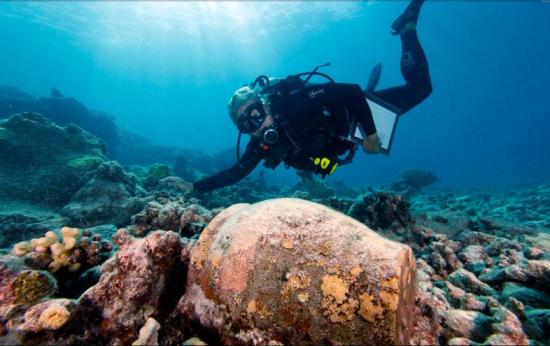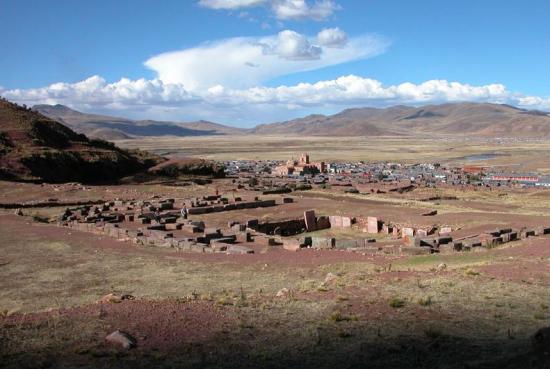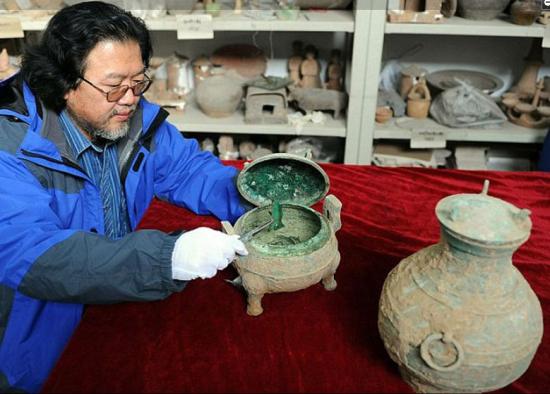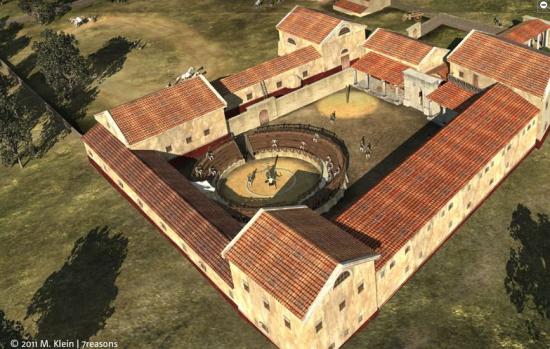TOP 10 - 2011
Source -http://www.archaeology.org/1201/features/australopithecus_arab_spring_pompeii_altamira.html
© 2012 by the Archaeological Institute of America
Years from now, when we look back on 2011, the year will almost certainly be defined by political and economic upheaval. At the same time that Western nations were shaken by a global economic slump, people in the Middle East and North Africa forcefully removed heads of state who had been in power for decades. “Arab Spring,” as the various revolutions have collectively been named, will have far-reaching implications, not just for the societies in which it took place, but also for archaeology. No year-end review would be complete without polling archaeological communities in the affected areas to determine whether sites linked to the world’s oldest civilizations, from Apamea in Syria to Saqqara in Egypt, are still intact. Of course, traditional fieldwork took place in 2011 as well. Archaeologists uncovered one of the world’s first buildings in Jordan. In Guatemala, a Maya tomb offered rare evidence of a female ruler, and, in Scotland, a boat was found with a 1,000-year-old Viking buried inside.
We also witnessed the impact that technology continues to have on archaeology. Researchers used a ground-penetrating radar survey of the site of a Roman gladiator school to create a digital model of what it may once have looked like. And scientists studying an early hominid have taken their investigation online by tapping the scientific blogging community. The team is seeking help to determine if they have actually found a sample of fossilized skin that appears to be more than 2 million years old. These projects stand as clear evidence that as cultures around the world undergo sweeping changes, so too does the practice and process of archaeology.
10 Arab Spring Impacts Archaeology - Libya/Egypt/Tunisia/Syria by Mike Elkin
No discussion of the year 2011 can be complete without a reference to what's been termed Arab Spring. The political phenomenon has the potential to have an extraordinary impact on archaeology for years to come.
In Libya, a Russian journalist broadcast that thieves plundered the country's museums and NATO bombed the ancient Roman sites of Leptis Magna and Sabratha. At the end of September, a three-person team from Blue Shield, a nonprofit organization concerned with the protection of cultural heritage in areas of conflict, traveled to western Libya and found Leptis Magna untouched. The theater at Sabratha suffered minor bullet damage, but the rest of the site was fine. Rebels had entered Tripoli's National Museum, but only wrecked Qaddafi's old cars on display; museum staff had previously hidden or moved important artifacts. Overall, the Blue Shield report said, they found no evidence of organized looting at the museums or archaeological sites they visited. Nevertheless, there are still concerns.
“There is a lot of hearsay, but artifacts have been smuggled out of the country through Egypt,” says Ray Bondin, Malta's ambassador to UNESCO, who has worked with Libyan heritage authorities for many years. “The sites are not well protected and the department of antiquities is still organizing itself.”
After rebels drove Qaddafi's forces from Benghazi, for instance, the so-called Treasure of Benghazi—around 8,000 bronze, silver, and gold coins and other artifacts from the ancient city of Cyrene near modern-day al-Bayda—disappeared from a bank vault.
Egypt appears to have been affected more than its westerly neighbor. After the revolution erupted in late January, then Minister of State for Antiquities Affairs Zahi Hawass offered assurances that all sites and artifacts were safe. Later, however, this proved not to be true. Looters had attacked dozens of sites and broke into storerooms throughout the country, including in the delta region, Abydos, Abu Sir, Giza, Dashur, Lisht, Saqqara, and Quntara. Thieves also pilfered artifacts from Cairo's Egyptian Museum, while protests and street battles went on outside in Tahrir Square.
Archaeologists in Egypt now say security has returned, but organization has faltered since the Mubarak regime fell. In an attempt to stabilize the situation, the Supreme Council of Antiquities (SCA) is no longer part of the Culture Ministry, and instead is part of Prime Minister Essam Sharaf's portfolio. “The SCA is going through a very painful auditing process,” says Tamar Teneishvili, a UNESCO specialist in Cairo. “And the treasury for cultural heritage management, funded by tourism, is empty.”
Tunisia, the first Arab Spring country to evict its dictator, appeared to have avoided post-uprising archaeological problems. Once Ben Ali and his family fled the country, however, an earlier, state-sponsored looting epidemic was discovered. On a program on France 2 television, Complément d'enquête, Fathi Bejaoui of Tunisia's National Heritage Institute was filmed as he entered Ben Ali's daughter's abandoned beach mansion. There they found nearly 200 artifacts used as decoration. Ancient columns held up a large exhaust hood in the kitchen and marble friezes were cut to frame the fireplace.
Syria could be the next country to oust a regime, but the government has sealed the country to outsiders and information is sparse. The state-run news agency reported in September 2011 that looters had hit the Seleucid city Apamea, not far from modern-day Hama, the seat of opposition to the Assad regime.
9 Atlantic Whaler Found in Pacific - French Frigate Shoals, Hawaii by Samir S. Pate

Photo: Courtesy the National Oceanic and Atmospheric Administration
America's whaling fleet expanded the country's global reach and transformed the economy of the Pacific in the 1800s. Very few wrecks of these vessels have ever been found, as they usually went down in deep water, far from shore. This year, federal marine archaeologists working at French Frigate Shoals in the Papahanaumokuakea Marine National Monument in Hawaii finally identified one—Two Brothers, a Nantucket whaler that sank in 1823. The discovery started with a 10-foot anchor, and also included three iron trypots in which blubber was rendered into oil, remnants of the ship's rigging, and another anchor. Two Brothers has a special place in literary history. It was the second ship led by hard-luck captain George Pollard Jr. His first was the Essex, which was rammed and sunk by a sperm whale, providing inspiration for Moby Dick. Oh, and the Essex crew, including Pollard, resorted to cannibalism while drifting and starving on the open ocean.
8 War Begets State - Lake Titicaca, Peru by Julian Smith

Photo: Courtesy Charles Stanish, Cotsen Institute of Archaeology at the University of California, Los Angeles
Near the northern end of Lake Titicaca in Peru, a team led by Charles Stanish of the University of California, Los Angeles, found evidence that warfare may have been critical in the formation of early states. The main line of evidence is a 38-yard-long layer of ash and debris in a high-status residential area of a settlement called Taraco, one of the two largest political centers in the region. The site-wide burn, dated to the first century A.D., was so intense it melted adobe walls and carbonized thatched roofs.
Taraco’s fortunes changed drastically after the fire. The production of high-quality pottery and obsidian artifacts plummeted, and residents shifted from building with fine stone to working in the fields. At the same time, the nearby settlement of Pukara took off, expanding its territory by at least 60 miles and showing characteristics of state-level societies such as urbanized settlements, a warrior class, and full-time craft specialists.
Put all that evidence together, and Stanish theorizes that Pukara attacked and destroyed its rival Taraco. After two millennia of coexistence, war had come to the Titicaca Basin—but instead of snuffing the early spark of civilization, it served as tinder. Cooperation between cultures can certainly be a path to success, but sometimes organized conflict can be a more efficient, logical way to acquire resources.
“The models of state formation that do not see warfare as a central key element do not have it right,” says Steve LeBlanc of Harvard University.
7 Ancient Chinese Takeout - Shaanxi/Xinjiang, China by Lauren Hilgers

Photo: M. Klein | 7Reasons, Imaginechina
Today, dog soup and millet noodles may be meals only an archaeologist could love. In two tombs at opposite ends of the country, archaeologists have found the remains of intriguing dishes, well preserved in bronze vessels and clay pots and buried with the dead. In a Warring States tomb in Shaanxi Province, one team found a soup containing what they believe to be dog bones. And in Subeixi Cemetery in Xinjiang, another group of archaeologists found 2,400-year-old intact noodles made of millet. With efforts to re-create the meals, archaeologists may soon be eating like the ancients.
6 Gladiator Gym Goes Virtual - Carnuntum, Austria by Jessica Woodard

Photo: Courtesy the Ludwig Boltzmann Institute for Archaeological Prospection and Virtual Archaeology
Ground-penetrating radar (GPR) technology has allowed an international team of researchers from the Ludwig Boltzmann Institute for Archaeological Prospection and Virtual Archaeology (LBI-ArchPro) to both identify a ludus(gladiator school) at the Roman city of Carnuntum in Austria and bring it before the public in an unprecedented way. What was once a vibrant city of 50,000 residents is now the site of an immense archaeological park. The newly discovered fourth-century A.D. gladiator school, the fourth largest ever found in the world, located just west of the largest amphitheater outside of Rome, is a self-enclosed complex that includes an inner courtyard, circular training area, living quarters, and a cemetery. The high-resolution images collected from the GPR survey show an under-floor heating system, bathing area, and walking paths within the complex. With the improved GPR technology developed by LBI-ArchPro, a complete picture of gladiator life is starting to emerge. Digitally re-created images of the ludus allow visitors to see how the school fit into the city’s landscape, and it’s possible to view them on a smartphone by using the free Wikitude World Browser software.
Part. 2